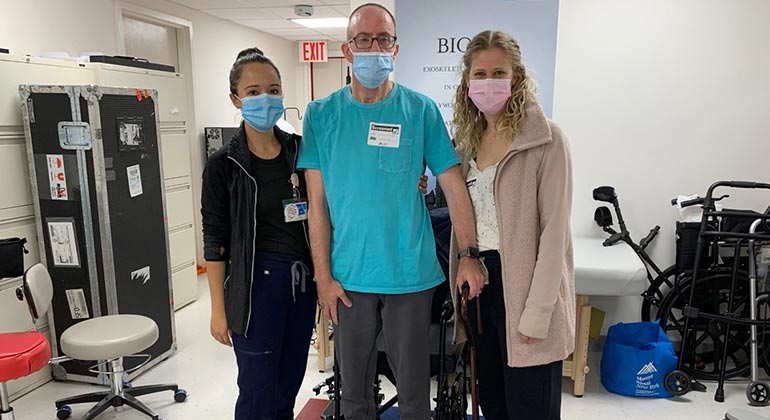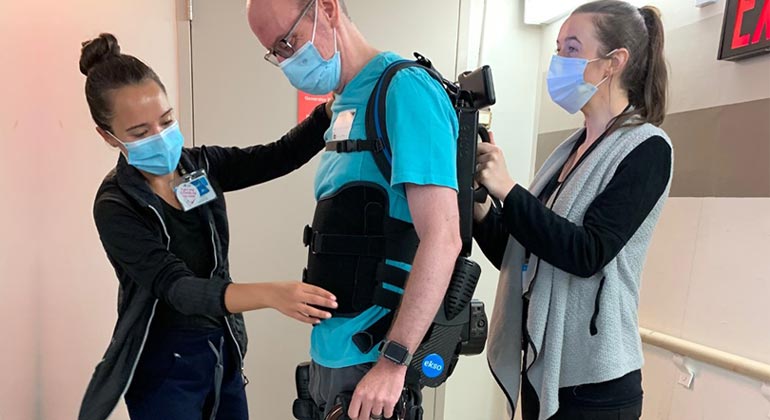

First Steps a Milestone for Stroke Survivor
In January, 2020, Jonathan Mender took his first steps at Mount Sinai’s Abilities Research Center with the help of an exoskeleton—a high-tech device that helps patients with neurological or spinal conditions to walk again. These steps were a huge milestone in the journey of this young stroke survivor.
In 2019, Jonathan, now 47 years old, was a dentist in New York City attending to a patient. He wasn’t feeling well—almost like he had a hangover—and he had scheduled a doctor’s appointment. However, while he was treating his patient, he suddenly felt dizzy and had to sit down.
“Some of his assistants took a blood pressure reading and it was off the scale,” Cory Turk, his wife, recalled. His office staff called an ambulance immediately, but on the ride to the hospital, Jonathan’s face started drooping, a tell-tale sign of a stroke. “They probably saved his life,” said Corey.
The doctors administered a clot-busting drug, and Jonathan became lucid again. But an artery in his neck developed a tear and his brain started swelling. Doctors performed a craniotomy —removing part of his skull—in order to relieve the pressure. Jonathan needed to be intubated and had a feeding tube placed.
However, that wasn’t the end of Jonathan’s complications. He developed pneumonia and the fluid around his brain started leaking into the incision in the back of his neck, and he required yet another surgery.
The stroke and its complications affected Jonathan’s ability to speak and swallow, as well as his motor coordination and balance. When he and his wife were looking to advance his rehabilitation care in order to meet his goals for independence, they didn’t give up.
Jonathan started working with the rehabilitation physical therapists at Mount Sinai’s Abilities Research Center (ARC). The ARC offers state-of-the-art advanced rehabilitation approaches, and is one of the few centers in the country to offer an outpatient exoskeleton program. The exoskeleton is a powered robotic which uses sensory technology and motors. Based on the patient’s observed walking pattern, the exoskeleton can be programed to create a stepping sequence that mimics the natural walking movement of the legs. It can be used by stroke survivors, or patients who have spinal paralysis, Parkinson’s disease, or other neurological conditions that affect movement.
“For patients like Jon, who really need a lot of external assistance, the exoskeleton allows him to start to walk with more independence,” says Jenna Tosto-Mancuso, Jon’s physical therapist at ARC. “It gives him motor support and physical feedback to retrain his brain to get back to a normal walking pattern.”
But while Jonathan has had mechanical support, his courage and resilience are all his own. While he was able to begin making headway at ARC, the pandemic halted his in-person sessions. He started up again in September 2020, working tirelessly to regain motor skills and walking ability. Recently he started walking without the help of an exoskeleton and can now walk without an assistive device with minimal assistance from his physical therapist. He even went for a walk in Central Park during a rehab session.
“He deserves so much credit for having that positive attitude of ‘I’m just going to keep going,’’ says Corey. And the staff at ARC are equally impressed. “He has made astronomical gains,” says Tosto-Mancuso.